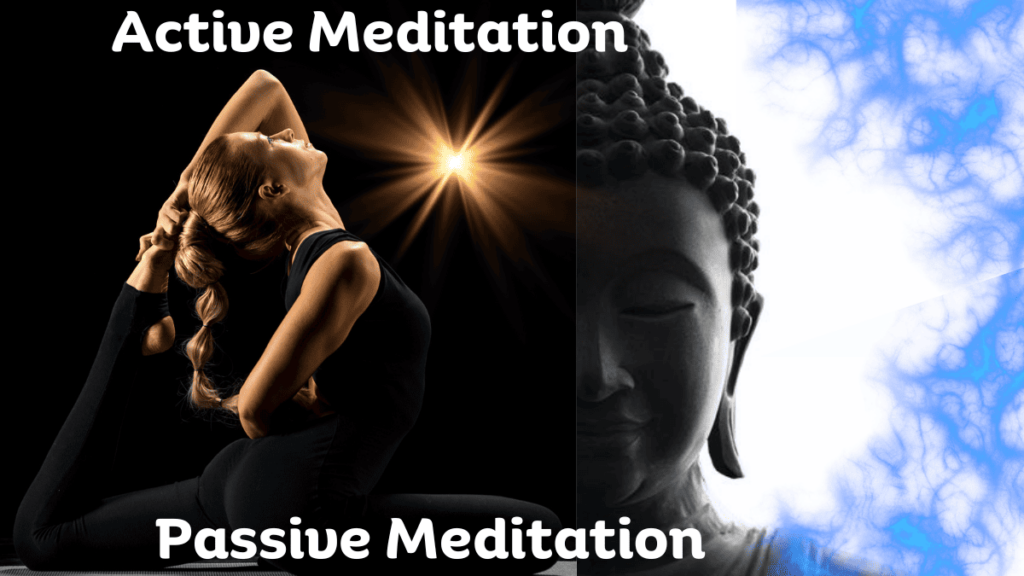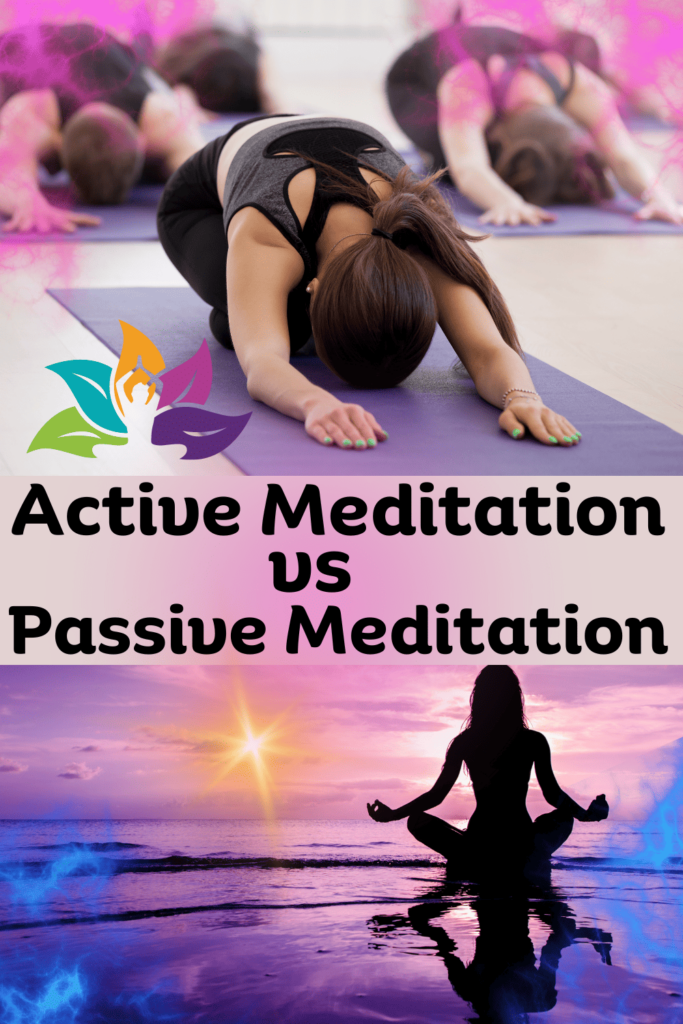
Active meditation involves mindful movement or activities, enhancing focus and reducing restlessness. Passive meditation, on the other hand, requires stillness to achieve inner calm and mental clarity. Both offer unique benefits for well-being.
| Active Meditation | Passive Meditation | |
|---|---|---|
| Definition | Cultivating mindfulness while moving or doing an activity | Sitting or lying still, often with eyes closed |
| Examples | Walking meditation, yoga, mantra repetition, mindful eating | Breath awareness, body scan, visualization, empty mind meditation |
| Benefits | Improved focus, bridging meditation into everyday life, energizing | Induces tranquility, equanimity, deep relaxation |
| Tips | Start with repetitive motions, schedule regularly, be patient | Minimize distractions, start short sessions, find a calming environment |
Meditation has become increasingly popular in modern society. It is an ancient practice that trains attention, awareness, and mindfulness.
There are two main styles of meditation: active and passive. While both cultivate presence and calm the mind, they have some key differences.
This article will explore what defines active and passive meditation and the unique benefits of each.
It will provide guidance to help determine which style resonates most with your personality and needs.
Regular, dedicated practice of either form of meditation can help develop concentration, reduce stress, and connect you to the present moment.
Finding the right balance for your mind and lifestyle is key.

What is Active Meditation?
Active meditation involves cultivating mindfulness while moving or doing an activity. Rather than sitting still, you bring awareness to the actions of the body and mind.
Some examples of active meditation include:
- Walking meditation – focusing on the sensations of walking
- Yoga – consciously linking movement and breath
- Mantra repetition – silently repeating a phrase during daily tasks
- Mindful eating – paying close attention to the tastes and textures of food
Active meditation provides an outlet for restless minds.
If you find it difficult to sit still, integrating mindfulness into movement can help train concentration and awareness.
It also bridges the gap between meditation and everyday life.
Benefits of active meditation include:
- Improved focus and reduced distractibility
- Increased mindfulness during routine activities
- An energizing and physically engaging practice
- The ability to calm the mind while on the go
Start by choosing simple, repetitive actions to practice with. You can actively meditate while washing dishes, brushing your teeth, or taking a shower. Over time, bring this mindful presence into all domains of life.
Using Your Senses in Active Meditation
Using your senses in meditation is often associated with a more active form of meditation known as mindfulness meditation.
Mindfulness meditation encourages practitioners to actively engage their senses to become fully present in the moment.
| Sensory Focus | Description |
| Mindful Listening | Focusing your sense of hearing on the sounds around you during activities like walking or dishwashing. |
| Mindful Seeing | Paying close visual attention to details, such as colors, textures, and patterns, as you move through your environment. |
| Mindful Smelling | Being aware of aromas and scents that arise during everyday activities like drinking tea, cooking, or being outdoors. |
| Mindful Tasting | Eating slowly and mindfully, savoring the flavors and textures of each bite during meals. |
| Mindful Touching | Bringing tactile awareness to simple tasks like brushing your hair, petting an animal, or washing your hands. |
Tuning into your senses grounds you in the present moment and enhances concentration during any type of active meditation.
Things like taking a mindful sensory walk or preparing a meal mindfully engage the senses in an active way.
Focusing on sensory details can make routine activities more vivid and meditative.

What is Passive Meditation?
Passive meditation involves sitting or lying still, often with eyes closed. The aim is to calm the mind by focusing attention on an anchor like the breath or a sensory object.
Some common forms of passive meditation include:
- Mindfulness of breathing – observing the inflow and outflow of breath
- Body scan – systematically bringing awareness to different body parts
- Visualization – forming mental images to focus the mind
- Open monitoring – observing thoughts and sensations without judgment
In passive meditation, you cultivate stillness and tranquility. By letting the mind settle, thoughts begin to slow down and you connect deeply with the present moment.
Benefits of passive meditation include:
- Decreased stress and anxiety
- Improved concentration and mental clarity
- Development of equanimity and inner peace
- Deep relaxation and rejuvenation
It is best to practice in a quiet environment without distractions or interruptions.
Start with short sessions of 5-10 minutes and gradually increase over time. Proper posture also supports stability of both mind and body.
Comparing Active and Passive Meditation
Now that we’ve explored active and passive meditation separately, let’s compare the two styles:
Motion vs. Stillness
In active meditation, it's all about getting your body involved. You're up and about, moving, grooving, and finding your zen in the midst of action. Whether you're practicing yoga or mindful walking, you're turning everyday activities into opportunities for mindfulness. Passive meditation, on the other hand, calls for stillness. Picture yourself sitting or lying down, eyes closed, and the world around you fades away. Here, you're not about physical motion; you're all about the still, quiet waters of inner peace.
Everyday Life vs. Retreat
Active meditation is your ticket to weaving mindfulness into the fabric of everyday life. You don't need a secluded retreat in the mountains; you can find your zen in the laundry room, during your daily jog, or even in the middle of a traffic jam. It's about being present in the midst of your usual hustle and bustle. Passive meditation tends to thrive in serene environments. It's where you're less likely to be interrupted by the world's distractions. Think of a cozy corner in your home, a peaceful park, or a tranquil meditation room. These are your sanctuaries for stillness.
Mind vs. Body
In active meditation, it's your body that takes center stage. You're honing in on your physical sensations, movements, and the dance of your breath. It's like a symphony where your body is the conductor, and you're listening to its every note. Passive meditation, conversely, is the realm of the mind. Here, your thoughts, emotions, and mental chatter are in the spotlight. You're not moving much physically, but your mind is exploring galaxies of thoughts and feelings.
Concentration vs. Awareness
Active meditation sharpens your concentration like a laser beam. It's all about pinpointing and immersing yourself in the task at hand. You're focusing on the sensations, the movements, and the experience in the now. Passive meditation, however, broadens your awareness. It's like expanding your view to encompass the entire landscape of your inner world. You're observing thoughts and sensations as they come and go, without actively engaging in them.
Energizing vs. Calming
Active meditation is your energy booster. It's like a shot of espresso for your mind and body. Engaging in mindful movement or sensory activities can leave you feeling invigorated, like a breath of fresh air on a sunny day. Passive meditation is the tranquilizer for your soul. It's your calm oasis in the chaos of life. By embracing stillness, you tap into a profound sense of calm, like a serene lake on a windless morning.
Beginning vs. Advanced
For beginners, passive meditation is often the welcoming door to the world of mindfulness. It's like dipping your toes into a cool stream before you dive deep. It's easier to learn because it doesn't require physical prowess. But as you grow on your mindfulness journey, integrating both active and passive meditation can be a game-changer. This combo deepens your practice, allowing you to dance through life with grace and tranquility.
The Key to Balance
Now, you might be wondering which is better – active or passive? The truth is, there’s no one-size-fits-all answer. Your path is unique, and the key is finding the right balance.
Experiment with both. Start with one style and, when you feel ready, incorporate elements of the other. Blend them to suit your energy, your goals, and your mood.
Remember, it’s not about perfection; it’s about consistency. Regular practice, whether active or passive, is your golden ticket to a more mindful, centered life.

Developing Your Meditation Practice
Try both styles – Experiment with different active and passive techniques to see what you enjoy. Observe how each affects your mind and body.
Start short – Begin with 5-10 minute sessions, then gradually increase. This allows the mind to ease into meditation.
Schedule regularly – Set a consistent daily meditation time. Routines reinforce the habit.
Minimize distractions – Practicing in a quiet, soothing environment helps minimize restlessness.
Be patient – Don’t expect immediate results. Allow your practice to develop over time.
Stay kind – Don’t judge yourself or get frustrated. Meditation is a process of gentle self-discovery.
Balance motion and stillness – For a complete practice, incorporate both active and passive meditation based on your energy levels.
Remember the purpose – The goal is presence and compassion. The style doesn’t matter as much as the sincerity.
Developing and deepening your meditation practice requires dedication over time. But the benefits are immense for mind, body and spirit. Be creative in finding a routine that works for your lifestyle.
Final Thoughts
Active and passive meditation provide complementary benefits for mind, body and spirit.
Active meditation integrates mindfulness into motion and everyday activities. It energizes the body while improving focus and concentration.
Passive meditation cultivates stillness and inner tranquility. By turning attention inward, it expands awareness and induces deep calm.
While beginners often start with passive meditation, developing a complete practice requires balancing both styles.
Experiment to find techniques that appeal to you. Start small and be consistent. Over time, you will find the meditation style and routine that suits your needs.
The key is regular, dedicated practice. With patience and self-compassion, meditation becomes the thread weaving presence into your life.
Frequently Asked Questions
How does active meditation differ from mindfulness practices?
Active meditation is a type of mindfulness practice, but it involves doing something while being mindful. For example, you can practice mindfulness during yoga or while eating. Mindfulness practices, on the other hand, often focus on being fully present in the moment without any specific activity. So, active meditation is like adding mindfulness to your daily actions.
How do the goals of active and passive meditation vary?
Active meditation aims to sharpen your focus, release stress, and cultivate awareness while you're engaged in an activity. It's about being present in the hustle and bustle of life. Passive meditation focuses on inner peace and stillness, calming the mind, and observing thoughts and sensations. It's like finding a quiet sanctuary within yourself.
What are some examples of active meditation?
Active meditation includes practices like mantra repetition, mindful movement (like yoga), deep breathing exercises, Tai Chi, walking meditation, and even chanting. These activities involve physical or mental engagement while staying mindful in the process.
Examples of passive meditation techniques?
Passive meditation techniques include breath awareness, loving-kindness meditation, body scan, silent meditation (Vipassana), transcendental meditation (TM), Zen meditation (Zazen), empty mind meditation, and sound meditation (Nada Yoga). These practices focus on stillness, inner observation, and calming the mind.
You may also be interested in: 1. Gratitude Meditation [20-minute Guided Meditation] 2. How to Live a Simple Life & Be Happy






